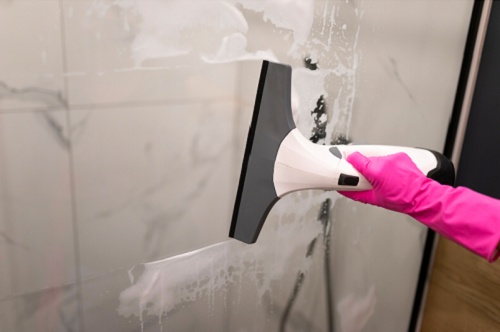Do you finally want to know how to protect bathroom walls from urine and deal with this problem once and for all? You’re in the right place. After all, we all want to enjoy our bathroom experience and even read a book while at it, and a dirty wall is not one of the ways to do so.
Having dirty bathroom walls is a problem you’re bound to deal with occasionally, especially if you have small boys trying to experiment with their aim.
The good news is that there are different ways to tackle this issue once and for all. Let’s learn how to protect bathroom walls from urine.
Why You Should Protect Your Bathroom Walls
The bathroom is a common area in a home, so it’s bound to get dirty in one way or the other. Keeping urine off the wall has many benefits, including:
Avoid Discoloration
When urine is left on the walls unattended for some time, it begins to cause discoloration, which is unsightly and also steals from the physical aspect of the walls.
Avoid Damage
You may not know it, but urine is a very strong and concentrated liquid. If left unattended, it can cause great damage to your walls, which will make you spend a lot on repair costs.
Prevent Foul Smell
Urine is highly concentrated and contains little water and ammonia. This is what gives it the strong, pungent smell. When it touches and lingers on the wall, the smell will remain there for a long time and will make you dread going to the bathroom.
Prevent the Spread of Viruses and Diseases
The bathroom as a common area is visited by both healthy and unhealthy people. That means you can pick up some viruses and diseases from a dirty toilet. Some of the diseases you can get from urine splash include typhoid and urinary schistosomiasis.
How to Protect Bathroom Walls from Urine
Now that we know why we need to protect our bathroom walls from urine, let’s look at the different ways of doing this.
Use a Toilet Splash Guard
A toilet splash guard is a low-maintenance equipment that fits in most toilet seats and elevated toilet seats. It fits on the front part of the toilet seat and ensures no urine escapes out of the toilet.
Before installing the male urine splash guard, make sure the wall or toilet bowl you plan to attach to is clean and disinfected.
Use White or Clear Caulking
If urine on bathroom walls is a major concern to you, especially those with toddlers who are not fully potty-trained, using white or clear caulk would be more sensible. These are water-resistant products that make the floors and walls around bathrooms look smooth and polished.
Putting caulk around the toilet will also prevent the accumulation of dirt and bacteria. Not only that but putting it around the base of the toilet helps prevent wobbling and emitting a foul smell.
A white or clear caulk doesn’t stain or turn yellow after some time, making it the best solution for around the toilet.
Use a Homemade Anti-Urine Solution
Protecting bathroom walls from pee doesn’t have to be an expensive affair. You can make your own anti-pee solution using ingredients already in your home.
Some of the household ingredients you can use include white vinegar, baking soda, essential oils, and water.
To use these products:
- Wear gloves and clean your walls thoroughly
- On one hand (steel wearing the gloves), pour a bit of baking soda and pat it on the affected area
- Let it sit for like 10 minutes before scrubbing vigorously
- Rinse the area using paper towels
- Make a mixture of any essential oil +vinegar + warm water
- Apply the mixture to the stain using a scrubbing pad and let it sit for a few minutes before wiping it off. This mixture works to disinfect the area and get rid of the pungent smell.
Apply Anti-urine Paint or Coating
One of the long-lasting solutions that will keep your bathroom walls free from pee is using anti-urine paint or coating.
Whether you’re dealing with your baby’s pee or pet pee, an anti urine paint or coating will help protect your walls by:
- Preventing nasty odors
- Reducing unpleasant stains
- Preventing urine from drenching into the walls
- Decreasing the risk of transmitting dangerous illnesses
You can buy your anti urine paint or coating from the nearest hardware store, hygiene retail store, or pet shop. Remember to read the manufacturer’s instructions before applying this solution to your walls.
Use Disposable Mats

Bathroom disposable mats are made of a unique formula that helps absorb pee and other stains. The good thing about these mats is that they are disposable and last up to four months.
They are meant to absorb large volumes of liquid on contact. The best part is that they have very high wicking capacity, so they can suck up any pools of water or pee that might otherwise sip into your bathroom walls.
Most of these disposable mats also come with a deodorizing agent and rubber backing that thwarts the growth of odor-causing bacteria.
How to Remove Dried Urine Stains From Painted Walls
As mentioned above, baking soda and vinegar can effectively remove urine from most walls.
If you have tried this solution without much success, then go ahead and try the bleach and warm water solution.
- Wear gloves and safety goggles to protect yourself from the bleach and other possibly corrosive substances that may be present in the urine.
- Mix one-part bleach to four parts warm water in a spray bottle or bucket and thoroughly combine all the ingredients.
- Apply or spray the mixture on the stain using a brush, cloth, or sponge. Let it sit there for close to 10 minutes, and scrub the surface gently using a soft brush or cloth.
- Wipe down the place using a clean damp cloth to ensure any left-over residues are removed.
- Rinse off the surface by spraying it with warm water and wiping it with a towel or another damp cloth. Allow it to dry completely, and reapply the sealant if necessary.
Warm water and bleach are safe ingredients for removing urine from your bathroom walls. They are powerful enough to do the job yet gentle and do not leave behind any damaging residue.
How Do You Get Urine Smell off Walls?
Urine smells more like ammonia, so you’ll need white vinegar to neutralize the smell.
- Wash and dry the affected area
- Make a solution of vinegar and warm water
- Spray the mixture on the affected area and give it about 10 minutes before wiping it off with paper towels.
Instead of the vinegar solution, you can also make a mixture of three tablespoons of baking soda, +one cup of peroxide + a few drops of dish detergent. Follow the same procedure of spraying the area, letting the mixture sit for some time, and wiping it off until the smell is eliminated.
Final Thoughts on How to Protect Bathroom Walls from Urine
Many homes or public toilets deal with the problem of urine on bathroom walls. But you don’t have to lose your sleep over this issue. Learning how to protect your bathroom walls from urine will help you get rid of the stench and keep your walls fresh.




I’d like to have my bathroom all done with a water proof coating and I want to have a new toilet as I have a plastic cistern. Where I would prefer ceramic cistern as I did in my other home.